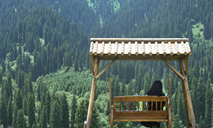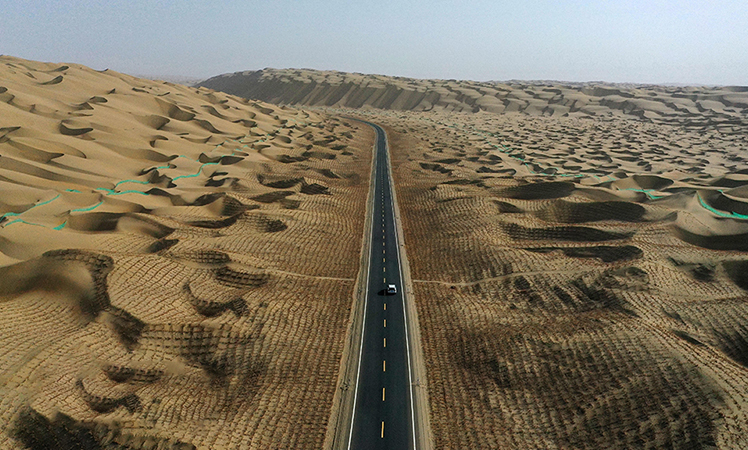Digitalization helps to preserve Mogao Grottoes of Dunhuang for future generations

① A visitor takes photos during an exhibition featuring Dunhuang relics in Wuhan, capital of central China’s Hubei Province. (Xinhua/Xiao Yijiu)
② File photo shows Li Deren (1st R), Zhu Yixuan (2nd L) and Fan Jinshi (1st L) discussing solutions for the digitalization of the Mogao Grottoes in Dunhuang city, northwest China’s Gansu Province.
③ Photo shows the Mogao Grottoes in Dunhuang city, northwest China’s Gansu Province. (Photo/Zhang Xiaoliang)
④ File photo shows Huang Xianfeng (R), Zhang Fan (C) and a staff member of the Dunhuang Academy collecting digital information about the Mogao Grottoes.
Thanks to the application of digital technologies, a 1:1 digital replica of the Mogao Grottoes, a UNESCO World Heritage site located in Dunhuang city, northwest China’s Gansu Province, has provided a virtual means for people to observe the spectacular cultural heritage at the site even if they never have the chance to actually visit the place in person.
By visiting the website “Digital Dunhuang” launched by the Dunhuang Academy, visitors from across the world can now be immersed with ultra-high-definition images of the murals found inside the Mogao Grottoes, the world’s largest, best-preserved and richest treasure trove of art that dates back to about 2,000 years ago.
To digitize Dunhuang’s many treasures, Chinese scientific researchers worked ceaselessly for more than a decade.
In the 1980s, Li Deren, an academician with the Chinese Academy of Sciences and the Chinese Academy of Engineering and a renowned expert in surveying and mapping, along with his wife Zhu Yixuan, a professor at the State Key Laboratory of Information Engineering in Surveying, Mapping and Remote Sensing at Wuhan University in central China’s Hubei Province, began to engage in the protection of the cultural relics found inside the Mogao Grottoes, many of which will see gradual fading as time passes by.
In 2005, the couple went to Dunhuang for an investigation trip and met Fan Jinshi, then president of the Dunhuang Academy. After argumentation, they decided to employ modern photogrammetry and remote sensing technologies to achieve the 3D digital reconstruction of the Mogao Grottoes and build a 3D digital model using a computer.
The state key laboratory of Wuhan University and Zhu’s team then started surveying and mapping the Mogao Grottoes and collecting all the relevant data.
In November 2007, Huang Xianfeng, who obtained a doctorate, also ventured to Dunhuang. Huang’s task was to scan the grottoes with laser scanners. But he found that the scanners couldn’t satisfy the requirements of the task.
Several months later, Huang went to Dunhuang again with scanners that met his requirements, but then the issue of data processing became a pressing concern.
In June 2008, Huang went to the Mogao Grottoes for a third time, together with Zhang Fan, a doctoral student of Li’s. This time, Huang decided to develop a kind of independent modeling software.
Huang and Zhang often collected digital data about the grottoes in the daytime and programmed at night. Three months later, they created a software tool that could handle high-quality texture mapping for complex models of sculptures found inside the Mogao Grottoes.
After these technical obstacles were overcome, Li put forward the idea of collecting more data to integrate the Mogao Grottoes with its surrounding environment in digital models. “In addition to data about the Mogao Grottoes, cultural heritage data in Dunhuang had to all be collected and recorded so that we could provide more comprehensive information for the protection of cultural heritage,” said Li, who is now in his eighties.
One year later, Huang led a team of nine researchers to Dunhuang. They conducted aerial surveys with airborne laser scanners, as well as applying the use of ground laser scanners, photogrammetry instruments and handheld laser scanners in an attempt to fully survey the Mogao Grottoes, obtaining all kinds of data on the cultural heritage site.
“In the past, we didn’t know the distance between grottoes as we didn’t have 3D data that could help us see the whole picture. Now we can even distinguish the thickness of the walls, which offers supporting data for the preservation of the grottoes,” Huang said.
Huang has been to Dunhuang more than 50 times over the past years to work on the protection of the grottoes. “We hope to keep the grottoes in a state of continual protection with the use of digital technologies,” Huang said.
“Thanks to artificial intelligence and augmented reality, cultural relics experts, historians and archaeologists can carry out research by visiting the website for Digital Dunhuang,” said Li. He introduced that the iconic figure of the flying Apsara found on the murals of the Mogao Grottoes can also be represented in the metaverse.
“In addition to collecting, processing and storing digital information on the Mogao Grottoes and relevant cultural relics, we have also measured deformations to the cliff body of the grottoes and restored the colors of the murals,” Li said, adding that protecting the Mogao Grottoes and passing on the culture of Dunhuang can contribute to the preservation and development of world civilization.
“We will continue to conduct research in this regard, including applying big data technology to mine data and analyze the painting styles of different eras, which will help confirm the periods when the murals in the grottoes were created,” Li said.
Photos
Related Stories
- People visit Mingsha Mountain and Crescent Spring scenic spot in Dunhuang
- China's Dunhuang brings architecture depicted in murals to life with 3D technology
- Seminar on Dunhuang Grotto art held online
- Aerial view of Mogao Grottoes in Dunhuang, Gansu
- Apricot blossoms add charm to Mingsha Mountain in Dunhuang
- View of Mogao Grottoes in Dunhuang, NW China's Gansu
- Dunhuang dance recreated with rice
- “Super mirror” on the Gobi desert in Dunhuang
- Dunhuang frescoes reproduced as woodblock prints
- Splendid Dunhuang: Millennial cultural embassy
Copyright © 2022 People's Daily Online. All Rights Reserved.









